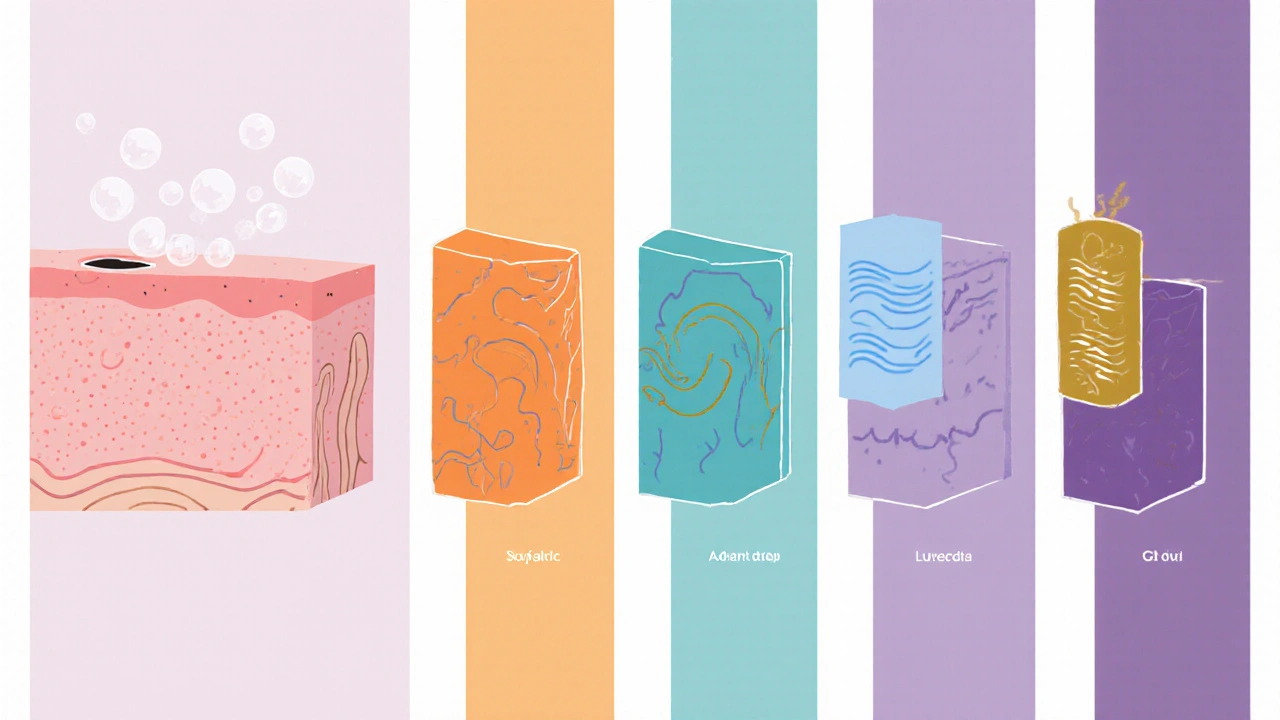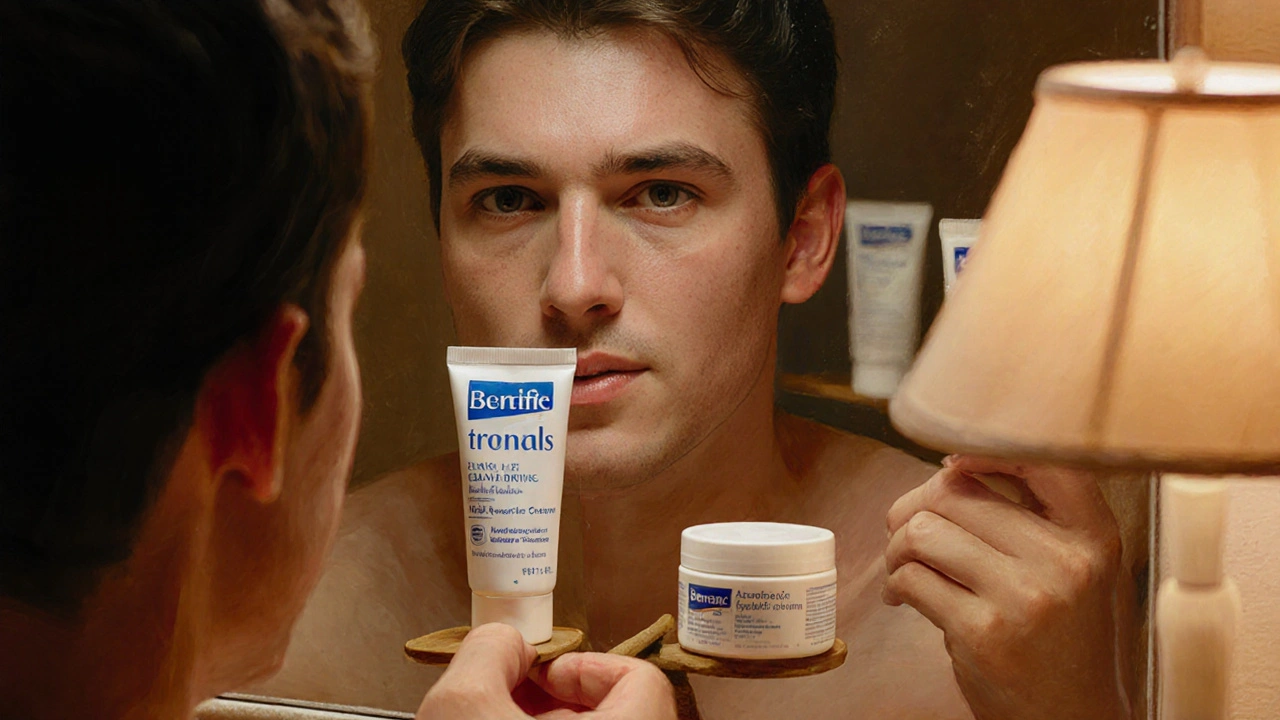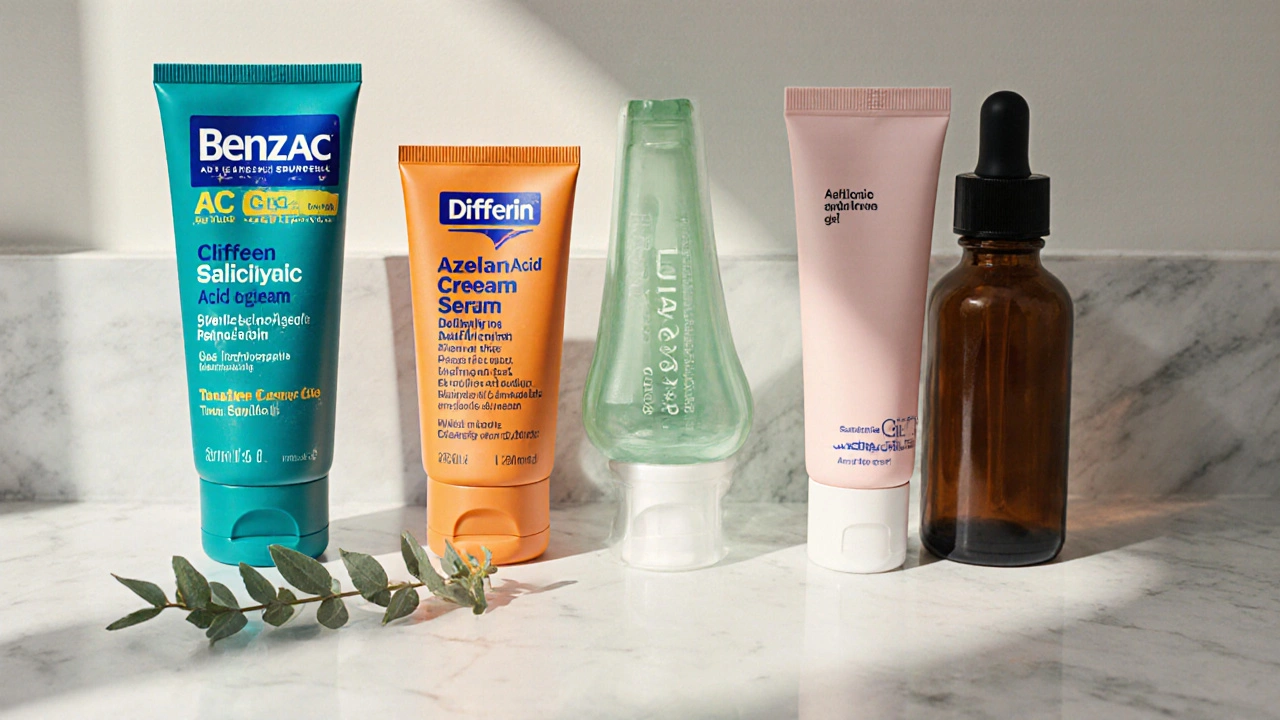When treating mild to moderate acne, Benzac AC Gel is a topical medication that delivers 5% benzoyl peroxide to the skin, helping to kill acne‑causing bacteria and unclog pores. But the market is crowded with other gels, creams, and even natural options that promise similar results. This guide breaks down how Benzac AC Gel stacks up against the most common alternatives so you can pick the product that fits your skin type, budget, and tolerance level.
Quick Takeaways
- Benzac AC Gel’s 5% benzoyl peroxide is excellent for oily or acne‑prone skin but can cause dryness and irritation.
- Adapalene (Differin) targets inflammation and works well for both acne and early signs of aging.
- Salicylic Acid gels are milder, ideal for sensitive skin, but may need longer treatment periods.
- Azelaic Acid cream offers antibacterial and keratolytic action with fewer side effects, great for rosacea‑prone users.
- Prescription combos like clindamycin‑benzoyl peroxide give fast results but require doctor supervision.
What Is Benzac AC Gel?
Benzac AC Gel contains 5% benzoyl peroxide, a well‑studied oxidizing agent that kills Propionibacterium acnes bacteria, reduces excess oil, and encourages peeling of dead skin cells. It’s available over the counter in many countries, including New Zealand, and is typically applied once or twice daily to clean, dry skin.
How Benzoyl Peroxide Works
The active ingredient releases oxygen into the pores, creating an environment where acne‑causing bacteria cannot survive. At the same time, it oxidizes the oily sebum that clogs pores, speeding up the turnover of surface skin cells. The downside? The same oxidation can irritate healthy skin, leading to redness, peeling, or a temporary worsening of breakouts.
Key Criteria for Comparing Acne Treatments
Before we jump into the alternatives, let’s set the yardsticks you’ll use to judge each product:
- Efficacy: Speed and extent of lesion reduction.
- Skin Tolerability: Likelihood of irritation, dryness, or allergic reactions.
- Usage Simplicity: Frequency of application and need for special routines.
- Cost: Average retail price for a month’s supply (based on 2025 NZ pricing).
- Additional Benefits: Anti‑aging, anti‑rosacea, or scar‑reduction properties.
Alternative #1 - Differin (Adapalene 0.1% Gel)
Differin Gel is a synthetic retinoid that modulates skin cell turnover and reduces inflammation. Unlike benzoyl peroxide, adapalene works from the inside out, preventing new comedones from forming.
Efficacy: Clinical trials show a 57% reduction in inflammatory lesions after 12 weeks, comparable to benzoyl peroxide but with a slower onset.
Skin Tolerability: Initial irritation is common, but it eases after 2-3 weeks. Users with dry or sensitive skin often prefer adapalene because it causes less bleaching of fabrics.
Cost: NZ$28-$32 for a 30g tube (approx. 3‑month supply).

Alternative #2 - Salicylic Acid Gel (2% Formula)
Salicylic Acid Gel is a beta‑hydroxy acid that exfoliates the inside of the pore, dissolving sebum and debris.
Efficacy: Best for mild comedonal acne; studies report a 30‑40% lesion reduction after 8 weeks.
Skin Tolerability: Very gentle; suitable for sensitive or post‑procedural skin, though it offers slower results.
Cost: NZ$12-$18 for a 50ml bottle.
Alternative #3 - Azelaic Acid Cream (15% Concentration)
Azelaic Acid Cream provides antibacterial, keratolytic, and anti‑inflammatory effects in one package.
Efficacy: Reduces both inflammatory lesions and hyperpigmentation; a 2023 study showed a 48% drop in total lesion count after 12 weeks.
Skin Tolerability: Low irritation profile, making it a favorite for rosacea‑prone users.
Cost: NZ$35-$40 for a 30g tube.
Alternative #4 - Prescription Combo: Clindamycin + Benzoyl Peroxide
Clindamycin‑Benzoyl Peroxide Gel pairs an antibiotic with a lower (2.5%) benzoyl peroxide concentration. The antibiotic reduces bacterial resistance while the peroxide tackles the oil.
Efficacy: Often the fastest‑acting option; many patients see noticeable improvement within 2 weeks.
Skin Tolerability: Higher risk of dryness and antibiotic‑related side effects; requires a prescription and periodic dermatologist review.
Cost: NZ$45-$55 for a 30g tube (often covered partially by health insurance).
Alternative #5 - Natural Option: Tea Tree Oil (5% Diluted Serum)
Tea Tree Oil Serum leverages the antimicrobial properties of melaleuca oil. When diluted to 5% in a carrier serum, it can be a gentler spot‑treatment.
Efficacy: Meta‑analysis in 2022 found a 29% reduction in acne severity versus placebo.
Skin Tolerability: Generally well‑tolerated, though some users experience mild irritation.
Cost: NZ$20-$25 for a 30ml bottle.

Side‑by‑Side Comparison
| Product | Active Ingredient | Typical % Concentration | Lesion Reduction (12wks) | Common Irritation | Average Monthly Cost (NZ$) |
|---|---|---|---|---|---|
| Benzac AC Gel | Benzoyl Peroxide | 5% | ≈55% | Dryness, peeling, bleaching | 12-15 |
| Differin Gel | Adapalene | 0.1% | ≈57% | Initial redness, scaling | 28-32 |
| Salicylic Acid Gel | Salicylic Acid | 2% | 30-40% | Minimal | 12-18 |
| Azelaic Acid Cream | Azelaic Acid | 15% | ≈48% | Low, occasional itching | 35-40 |
| Clindamycin‑Benzoyl Peroxide Gel | Clindamycin + Benzoyl Peroxide | 1% + 2.5% | ≈65% | Dryness, rare antibiotic reactions | 45-55 |
| Tea Tree Oil Serum | Melaleuca Oil | 5% (diluted) | ≈29% | Occasional mild irritation | 20-25 |
How to Choose the Right Option for You
Follow these three steps to land on the best product:
- Identify your skin type and primary concern. Oily, acne‑prone skin usually tolerates benzoyl peroxide; sensitive or rosacea‑prone skin benefits from azelaic acid or low‑strength salicylic acid.
- Set a realistic timeline. If you need quick results (e.g., before a wedding), a prescription combo may be worth the doctor visit. For gradual, long‑term improvement, start with a milder agent like adapalene.
- Factor in budget and convenience. Over‑the‑counter gels cost less and need no prescription, but if you’re already seeing side effects, switching to a pricier but gentler option may save you money on moisturizers and doctor visits.
Practical Usage Tips & Safety
- Always start with a patch test: apply a pea‑size amount to the jawline and wait 24hours.
- Apply to clean, dry skin. Wait 5‑10 minutes after washing before applying any active treatment.
- Use a non‑comedogenic moisturizer within 30 minutes to reduce dryness.
- Never combine two strong oxidizing agents (e.g., benzoyl peroxide + high‑strength vitamin C) in the same routine.
- For Benzac AC Gel, wash pillowcases and towels weekly to avoid bleach stains.
Frequently Asked Questions
Can I use Benzac AC Gel and Differin together?
It’s generally not recommended because both are strong retinoid‑type actives. Using them together can cause severe irritation. If you want to alternate, try using Benzac AC Gel in the morning and Differin at night, but monitor your skin closely and consider consulting a dermatologist.
How long does it take for Benzac AC Gel to show results?
Most users notice a reduction in redness and fewer new pimples within 2‑4 weeks, but the full 50‑60% lesion drop typically appears after 8‑12 weeks of consistent use.
Is Benzac AC Gel safe for pregnant women?
Benzoyl peroxide is classified as Category B for pregnancy, meaning animal studies show no risk but human data are limited. Most dermatologists advise pregnant women to choose milder options like azelaic acid or consult their physician before starting any acne treatment.
Why does my clothing bleach when I use Benzac AC Gel?
Benzoyl peroxide releases oxygen, which can oxidize fabric dyes. To prevent stains, let the gel fully absorb (about 10 minutes) before dressing, and use dark‑colored or synthetic fabrics that are less prone to bleaching.
Can I switch from a prescription combo to an over‑the‑counter gel?
Yes, but taper down gradually. Start by using the over‑the‑counter product every other night while monitoring for flare‑ups. If acne rebounds, you may need to stay on the combo or try a different oral medication.

Mary Cautionary
October 12, 2025 AT 21:20One must acknowledge the elevated pharmacological precision of benzoyl peroxide, yet the treatise neglects the nuanced interplay between epidermal microbiota and long‑term dermal resilience, an omission that betrays a superficial adherence to commercial imperatives.
Crystal Newgen
October 13, 2025 AT 11:13Nice rundown, I appreciate the clear tables and the practical tips. I’ll probably start with the salicylic gel since my skin is on the sensitive side.
Hannah Dawson
October 14, 2025 AT 01:07The analysis feels a bit rushed-no mention of how benzoyl peroxide can exacerbate hormonal fluctuations or interact with common OTC retinoids, which many of us already juggle in our nightly routines.
Julie Gray
October 14, 2025 AT 15:00It is no coincidence that the manufacturers of Benzac AC Gel have undisclosed ties to large dermatological conglomerates; the push for 5% formulations masks a covert agenda to marginalise cheaper, natural alternatives.
Lisa Emilie Ness
October 15, 2025 AT 04:53Good summary.
Emily Wagner
October 15, 2025 AT 18:47From a systems‑theory perspective, each acne agent can be modelled as a node within a feedback loop; benzoyl peroxide provides the activation energy, while adapalene offers regulatory damping, creating a dynamic equilibrium that can be tuned.
Mark French
October 16, 2025 AT 08:40Honestly, I think the guide is quite thorough; it covers a lot of ground and helps people figure out what might work best for them. Its tone is friendly even though it sounds formal, and that’s great for readers who are new to skincare. I’m sure many will find the patch‑test advice especially useful. If you’re unsure, starting slow is always a safe bet.
Daylon Knight
October 16, 2025 AT 22:33Oh great, another “ultimate guide” that tells us to buy more overpriced stuff. Because nothing says “trust me” like a table of prices from New Zealand. 🙄
John Petter
October 17, 2025 AT 12:27While the data is solid, one cannot ignore the aesthetic bias that elevates synthetic actives over time‑tested botanicals.
Annie Tian
October 18, 2025 AT 02:20What a comprehensive post! 🎉 The breakdown of cost versus efficacy is especially helpful; I love how you included the bleaching warning-so many forget that detail! Keep up the great work!!!
April Knof
October 18, 2025 AT 16:13The cultural context of acne treatments is fascinating; it’s interesting to see how different regions prefer certain actives over others.
Tina Johnson
October 19, 2025 AT 06:07Frankly, the guide omits the critical point that benzoyl peroxide monotherapies often lead to antibiotic resistance when later combined with clindamycin; you should caution readers about sequential usage to avoid creating super‑bugs.
Sharon Cohen
October 19, 2025 AT 20:00Sure, the table looks neat, but let’s not pretend that every teenager will follow a 12‑week protocol without the drama of breakouts, hormone swings, and last‑minute school projects.
Rebecca Mikell
October 20, 2025 AT 09:53I agree with the earlier points and would add that rotating between a gentle salicylic gel and a retinoid can prevent tolerance buildup while still delivering steady improvement.
Ellie Hartman
October 20, 2025 AT 23:47For those new to this, remember that consistency beats intensity; a modest regimen sustained over months typically yields better long‑term skin health than occasional aggressive spikes.
Alyssa Griffiths
October 21, 2025 AT 13:40Jason Divinity
October 22, 2025 AT 03:33One cannot help but marvel at the kaleidoscopic tableau of topical agents-each a chromatic brushstroke on the canvas of dermal regeneration. Yet, let us not be seduced solely by the siren song of “fast results”; the true artistry lies in harmonising efficacy with tolerability, lest we paint a picture of irritation. In this grand theater of cutaneous care, the audience is our epidermis, and it deserves a script that balances drama with subtlety.
andrew parsons
October 22, 2025 AT 17:27While the article is well‑structured, it neglects to address the ethical implications of prescribing clindamycin‑benzoyl peroxide combos without proper antibiotic stewardship. 🌐📚🛡️ This oversight could inadvertently promote antimicrobial resistance, a serious public‑health concern!
Sarah Arnold
October 23, 2025 AT 07:20Hey folks! 😊 Let’s break down the key take‑aways in a way that’s easy to remember and actually useful when you’re standing in front of the bathroom mirror. First, always start slow – a pea‑size amount of any active (whether it’s Benzac AC, Differin, or a salicylic gel) applied to a clean, dry face is enough to gauge tolerance. If you notice excessive dryness or a tingling sensation, back off and introduce a gentle, non‑comedogenic moisturizer within 15‑30 minutes; this helps seal in moisture and reduces the risk of barrier damage.
Second, timing matters. Benzoyl peroxide works best when used in the morning because it oxidises sebum throughout the day, while retinoids like adapalene are typically night‑only to avoid photoinstability. Pairing them incorrectly (for example, layering a strong peroxide with a high‑strength vitamin C serum) can cause oxidative stress and irritation.
Third, consider your skin type. Oily, acne‑prone skin can usually tolerate the 5% benzoyl peroxide in Benzac AC without too much trouble, but if you have rosacea‑prone or sensitive skin, you might find azelaic acid or a low‑strength salicylic gel far more forgiving. Remember that azelaic acid also tackles post‑inflammatory hyperpigmentation, which is a bonus if you’re dealing with dark spots.
Fourth, keep an eye on your laundry. Benzoyl peroxide is a bleaching agent – let the product absorb for at least ten minutes before you put on your pillowcase or shirt, and opt for dark‑coloured fabrics when possible. A quick tip: use a separate towel for the night to avoid transferring the peroxide onto bedsheets.
Fifth, be patient with results. Most users see a noticeable reduction in new lesions within 2‑4 weeks, but the full 50‑60% improvement usually takes 8‑12 weeks of consistent use. If you’re aiming for the fast track (like before a wedding), a prescription combo of clindamycin with a lower‑strength peroxide can deliver quicker results, but only under a dermatologist’s supervision.
Lastly, always patch‑test. Apply a pea‑size amount to your jawline for 24 hours. If you experience severe redness, itching, or swelling, discontinue use and consult a professional. Your skin will thank you for the extra caution! 🌟
Rajat Sangroy
October 23, 2025 AT 21:13Great job, Sarah! 🙌 I’d add that you can boost the effectiveness of any of these treatments by incorporating a short, 5‑minute low‑intensity LED session a few times a week – it speeds up healing and reduces inflammation. Keep pushing forward and don’t forget to stay consistent!